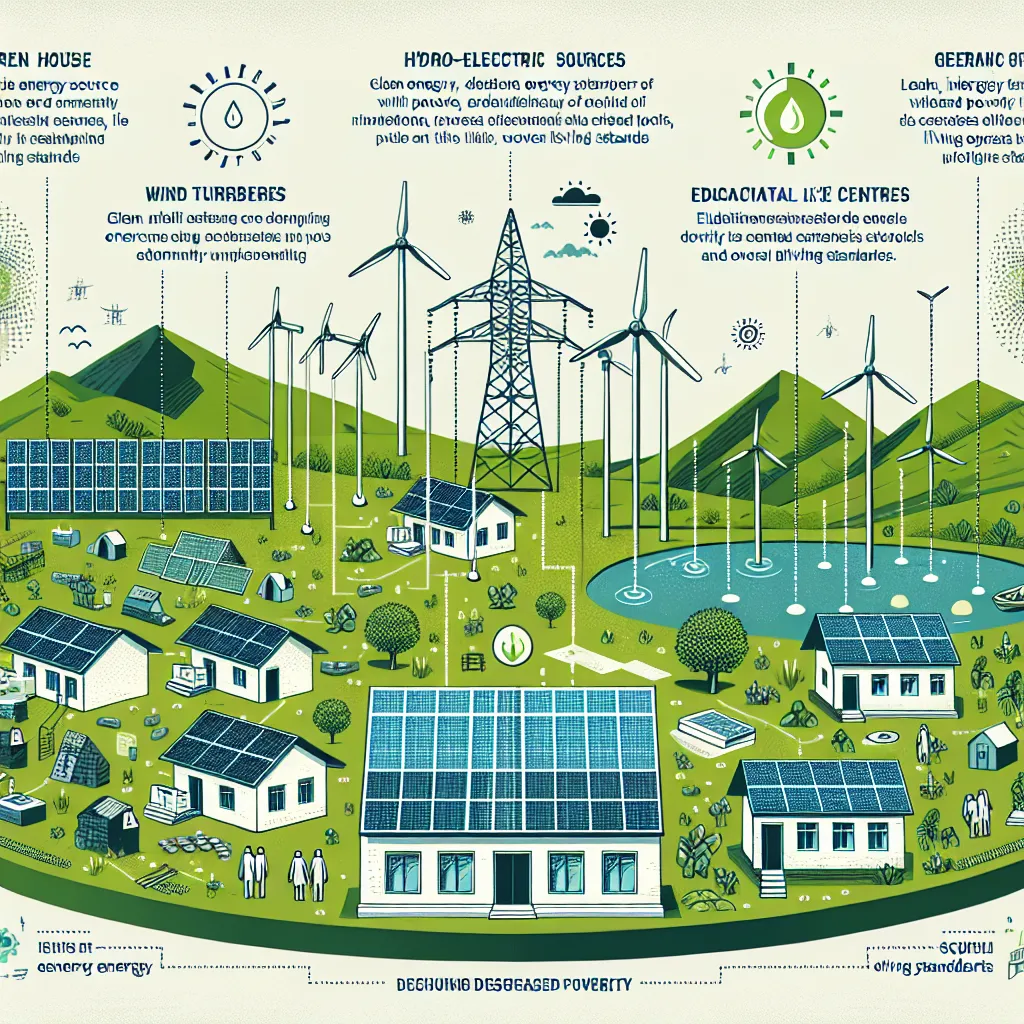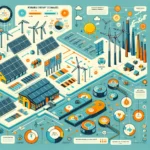Welcome to our IELTS Reading practice session focused on the crucial topic of “How Renewable Energy Can Reduce Global Poverty.” As an experienced IELTS instructor, I’m here to guide you through a comprehensive reading exercise that will not only enhance your understanding of this important subject but also sharpen your IELTS Reading skills.
 Renewable Energy and Poverty Reduction
Renewable Energy and Poverty Reduction
IELTS Reading Practice Test: Renewable Energy and Global Poverty Reduction
Let’s dive into our IELTS Reading practice test, which consists of three passages of increasing difficulty. Each passage is followed by a variety of question types to test your comprehension and analytical skills.
Passage 1 (Easy Text): The Basics of Renewable Energy
Renewable energy is a cornerstone of sustainable development and has the potential to significantly impact global poverty reduction. Unlike fossil fuels, renewable energy sources such as solar, wind, and hydropower are inexhaustible and environmentally friendly. These sources can provide reliable and affordable energy to remote and impoverished communities, often bypassing the need for expensive traditional energy infrastructure.
The implementation of renewable energy projects in developing countries has shown promising results. For instance, solar-powered micro-grids have brought electricity to villages that were previously off the grid, enabling children to study after dark and allowing small businesses to operate more efficiently. Wind farms in coastal areas have not only generated clean energy but also created job opportunities for local communities.
Moreover, the decentralized nature of many renewable energy systems makes them particularly suitable for rural and isolated areas. This characteristic allows for energy independence and reduces reliance on centralized power systems that may be unreliable or non-existent in many poverty-stricken regions.
As the cost of renewable technologies continues to decline, their adoption becomes increasingly feasible for developing nations. This trend is further supported by international initiatives and funding programs aimed at promoting clean energy solutions in the fight against poverty.
Questions 1-5: Multiple Choice
Choose the correct letter, A, B, C, or D.
-
Renewable energy sources are described as:
A) Expensive
B) Inexhaustible
C) Limited
D) Polluting -
Solar-powered micro-grids have enabled:
A) Children to play more
B) Adults to work longer hours
C) Students to study after dark
D) Villages to become more isolated -
Wind farms in coastal areas have:
A) Increased pollution
B) Reduced fishing opportunities
C) Created job opportunities
D) Decreased energy production -
The decentralized nature of renewable energy systems is particularly beneficial for:
A) Urban areas
B) Industrial zones
C) Rural and isolated areas
D) Wealthy neighborhoods -
The adoption of renewable technologies in developing nations is becoming more feasible due to:
A) Increasing costs
B) Declining costs
C) Government restrictions
D) Reduced international support
Questions 6-10: True/False/Not Given
Do the following statements agree with the information given in the passage?
Write:
TRUE if the statement agrees with the information
FALSE if the statement contradicts the information
NOT GIVEN if there is no information on this
- Renewable energy sources are more environmentally friendly than fossil fuels.
- Solar-powered micro-grids have been unsuccessful in providing electricity to remote villages.
- Wind farms have only been implemented in coastal areas.
- The decentralized nature of renewable energy systems increases reliance on centralized power systems.
- International initiatives are supporting the adoption of clean energy solutions in developing countries.
Passage 2 (Medium Text): Economic Implications of Renewable Energy in Developing Countries
The integration of renewable energy into developing economies presents a multifaceted approach to poverty alleviation. Beyond the immediate benefits of access to electricity, the renewable energy sector catalyzes economic growth through various channels, creating a ripple effect that extends far beyond the energy industry itself.
One of the most significant economic impacts is job creation. The renewable energy sector requires a diverse workforce, from highly skilled engineers and technicians to construction workers and maintenance personnel. This employment spectrum not only provides immediate income opportunities but also fosters skill development and knowledge transfer within communities. For instance, the International Renewable Energy Agency (IRENA) reports that the solar photovoltaic (PV) sector alone could employ 18 million people by 2050, with a significant portion of these jobs in developing countries.
Furthermore, the localization of energy production through renewable sources can lead to substantial cost savings for developing nations. Many of these countries currently rely heavily on imported fossil fuels, which exposes them to volatile international energy markets and drains valuable foreign exchange reserves. By harnessing indigenous renewable resources, countries can redirect funds previously spent on fuel imports towards other critical areas of development such as healthcare, education, and infrastructure.
The decentralized nature of many renewable energy systems also promotes entrepreneurship and small business development in rural areas. With reliable access to electricity, local entrepreneurs can establish and expand businesses, ranging from phone charging services to refrigeration for perishable goods. This economic activity at the grassroots level is crucial for creating sustainable pathways out of poverty.
Moreover, renewable energy projects often attract foreign direct investment (FDI) and international cooperation. Developed nations and multinational corporations are increasingly looking to invest in clean energy projects in developing countries, bringing not only capital but also technology and expertise. These investments can stimulate local economies and contribute to the transfer of skills and knowledge.
However, it is important to note that the transition to renewable energy is not without challenges. Initial capital costs can be high, and there may be resistance from established fossil fuel industries. Additionally, the successful implementation of renewable energy projects requires supportive policy frameworks, adequate infrastructure, and capacity building within local communities.
Despite these challenges, the long-term economic benefits of renewable energy in poverty reduction are compelling. As technology continues to advance and costs decrease, the potential for renewable energy to drive economic growth and improve living standards in developing countries becomes increasingly evident.
Questions 11-15: Matching Headings
Match the following headings to the correct paragraphs in the passage. Write the correct number (i-viii) next to questions 11-15.
i. Challenges in renewable energy adoption
ii. Job creation in the renewable sector
iii. Foreign investment opportunities
iv. Cost benefits of local energy production
v. Entrepreneurship in rural areas
vi. Environmental impacts of renewable energy
vii. Technology transfer in developing countries
viii. The ripple effect of renewable energy on economies
- Paragraph 2: __
- Paragraph 3: __
- Paragraph 4: __
- Paragraph 5: __
- Paragraph 6: __
Questions 16-20: Sentence Completion
Complete the sentences below. Choose NO MORE THAN THREE WORDS from the passage for each answer.
- The renewable energy sector requires workers ranging from highly skilled engineers to __.
- IRENA predicts that by 2050, the solar PV sector could employ __ people globally.
- Many developing countries currently depend on __, which makes them vulnerable to market volatility.
- Reliable access to electricity allows local entrepreneurs to establish businesses such as __ services.
- The transition to renewable energy faces challenges including high __ and resistance from existing industries.
Passage 3 (Hard Text): Technological Innovations and Policy Frameworks for Renewable Energy in Poverty Reduction
The nexus between renewable energy and poverty reduction is increasingly being strengthened by rapid technological advancements and evolving policy frameworks. These developments are not only making clean energy more accessible and affordable but are also creating new paradigms for sustainable development in impoverished regions.
One of the most promising technological innovations is the development of smart microgrids. These systems combine renewable energy sources, energy storage solutions, and intelligent distribution systems to provide reliable and efficient power to remote communities. Unlike traditional grid extensions, which can be prohibitively expensive to implement in rural areas, smart microgrids offer a scalable and adaptable solution. They can start small and grow as demand increases, making them an ideal fit for developing economies with limited resources.
Advances in energy storage technology, particularly in battery systems, are addressing one of the key challenges of renewable energy: intermittency. Lithium-ion batteries have seen dramatic cost reductions and efficiency improvements, making it feasible to store solar and wind energy for use during non-generating hours. This reliability is crucial for supporting continuous economic activities and essential services in poor communities.
Moreover, the emergence of pay-as-you-go (PAYG) systems and mobile payment platforms has revolutionized the financing and distribution of small-scale solar systems in developing countries. This innovative approach allows users to make incremental payments for their solar home systems, often using mobile money, making clean energy accessible to those with limited and irregular incomes.
On the policy front, many developing nations are implementing feed-in tariffs (FITs) and renewable portfolio standards (RPS) to incentivize investment in renewable energy. These policies provide long-term contracts to renewable energy producers, often at a fixed price, thereby reducing investment risk and encouraging market growth. For instance, Kenya’s implementation of FITs has led to a significant increase in renewable energy projects, particularly in rural areas.
International cooperation is also playing a crucial role in shaping supportive policy environments. The Paris Agreement on climate change has catalyzed global efforts to transition to clean energy, with developed nations pledging financial and technical support to developing countries. Initiatives like the Green Climate Fund are channeling billions of dollars into renewable energy projects in the poorest nations, helping to bridge the finance gap that often hinders implementation.
However, the success of these technological and policy innovations in reducing poverty through renewable energy depends on their contextualization to local conditions. A one-size-fits-all approach is rarely effective. Policymakers and project developers must consider factors such as local resource availability, existing infrastructure, cultural norms, and economic conditions when designing and implementing renewable energy solutions.
Furthermore, there is a growing recognition of the need for an integrated approach that links renewable energy projects with broader development goals. This means not only providing clean electricity but also ensuring that this energy catalyzes improvements in education, healthcare, agricultural productivity, and local industry. For example, solar-powered irrigation systems can significantly boost agricultural yields, while clean energy for schools can support better educational outcomes through improved lighting and access to information technology.
As we look to the future, emerging technologies such as artificial intelligence (AI) and the Internet of Things (IoT) hold promise for further optimizing renewable energy systems in poverty reduction efforts. AI can enhance the efficiency of energy distribution and consumption, while IoT can enable real-time monitoring and maintenance of remote energy systems, ensuring their longevity and reliability.
In conclusion, the convergence of innovative technologies and supportive policies is creating unprecedented opportunities for renewable energy to address global poverty. By providing clean, affordable, and reliable energy, these advancements are empowering communities to break the cycle of poverty and build sustainable livelihoods. However, realizing this potential will require continued investment, policy support, and a commitment to tailoring solutions to local contexts.
Questions 21-25: Matching Features
Match the following features with the correct descriptions. Write the correct letter A-H next to questions 21-25.
Features:
A) Smart microgrids
B) Lithium-ion batteries
C) Pay-as-you-go systems
D) Feed-in tariffs
E) Green Climate Fund
F) Artificial Intelligence
G) Internet of Things
H) Solar-powered irrigation systems
- Allows users to make incremental payments for solar home systems __
- Addresses the intermittency challenge of renewable energy __
- Channels billions of dollars into renewable energy projects in poor nations __
- Combines renewable sources with intelligent distribution systems __
- Can significantly boost agricultural yields __
Questions 26-30: Summary Completion
Complete the summary below. Choose NO MORE THAN TWO WORDS from the passage for each answer.
Technological innovations and policy frameworks are crucial in leveraging renewable energy for poverty reduction. Smart microgrids offer a(n) (26) __ solution for remote communities, while advances in (27) __ technology address the intermittency issue of renewable sources. On the policy front, many developing nations are implementing (28) __ to incentivize investment in renewable energy. The success of these innovations depends on their (29) __ to local conditions, and there is a growing recognition of the need for a(n) (30) __ that links renewable energy projects with broader development goals.
Answer Keys and Explanations
Passage 1 Answers:
- B
- C
- C
- C
- B
- TRUE
- FALSE
- NOT GIVEN
- FALSE
- TRUE
Passage 2 Answers:
- ii
- iv
- v
- iii
- i
- maintenance personnel
- 18 million
- imported fossil fuels
- phone charging
- capital costs
Passage 3 Answers:
- C
- B
- E
- A
- H
- scalable
- battery
- feed-in tariffs
- contextualization
- integrated approach
Conclusion: Mastering IELTS Reading on Renewable Energy and Global Poverty
This practice test has provided you with a comprehensive exploration of how renewable energy can reduce global poverty, while also honing your IELTS Reading skills. Remember, success in IELTS Reading comes from regular practice, building vocabulary, and developing effective time management strategies.
For more insights on related topics, check out our articles on the role of solar energy in rural development and how alternative energy sources are changing the energy market. These resources will further enhance your understanding of renewable energy’s impact on global development.
Keep practicing, stay curious, and you’ll be well on your way to achieving your desired IELTS score. Good luck with your IELTS preparation!


